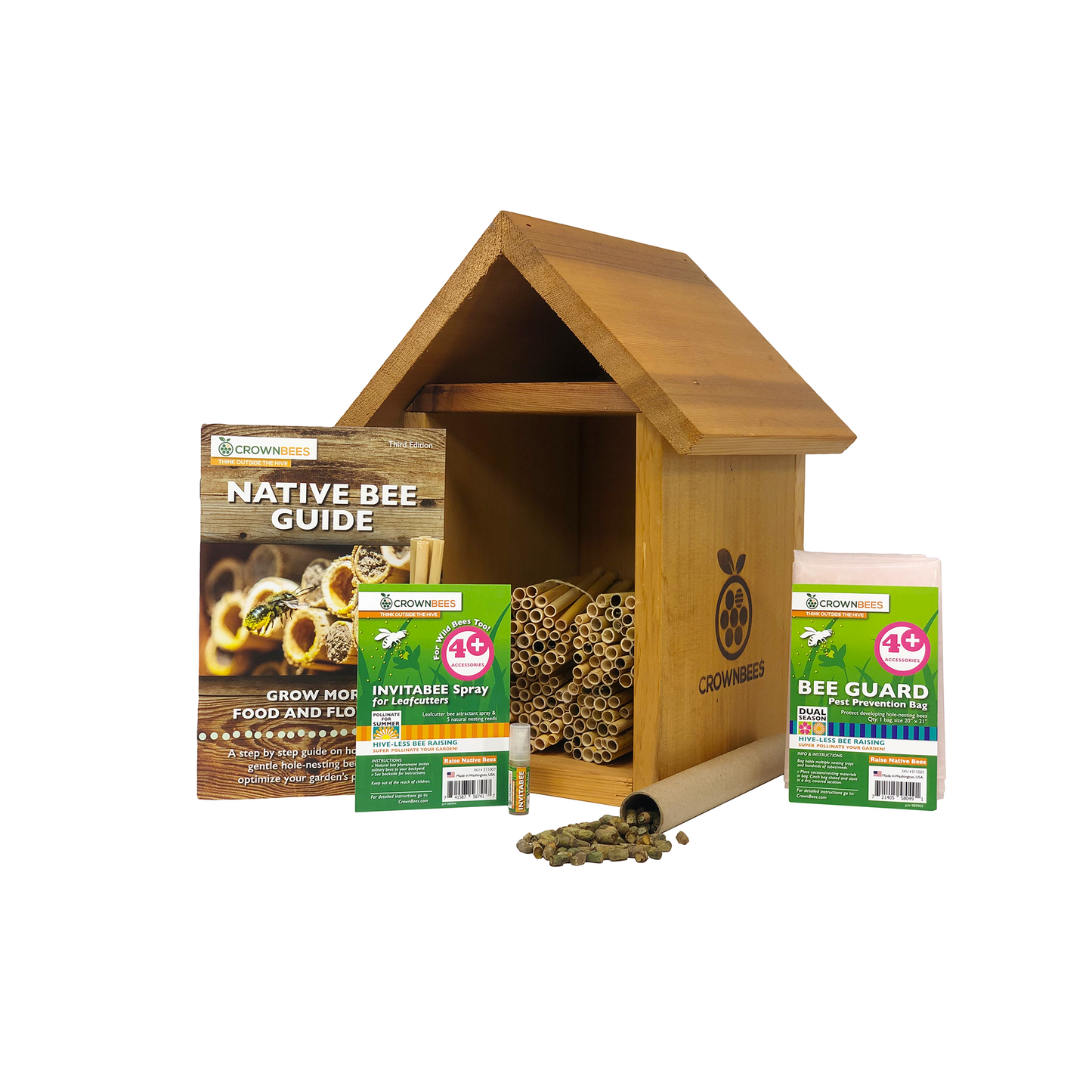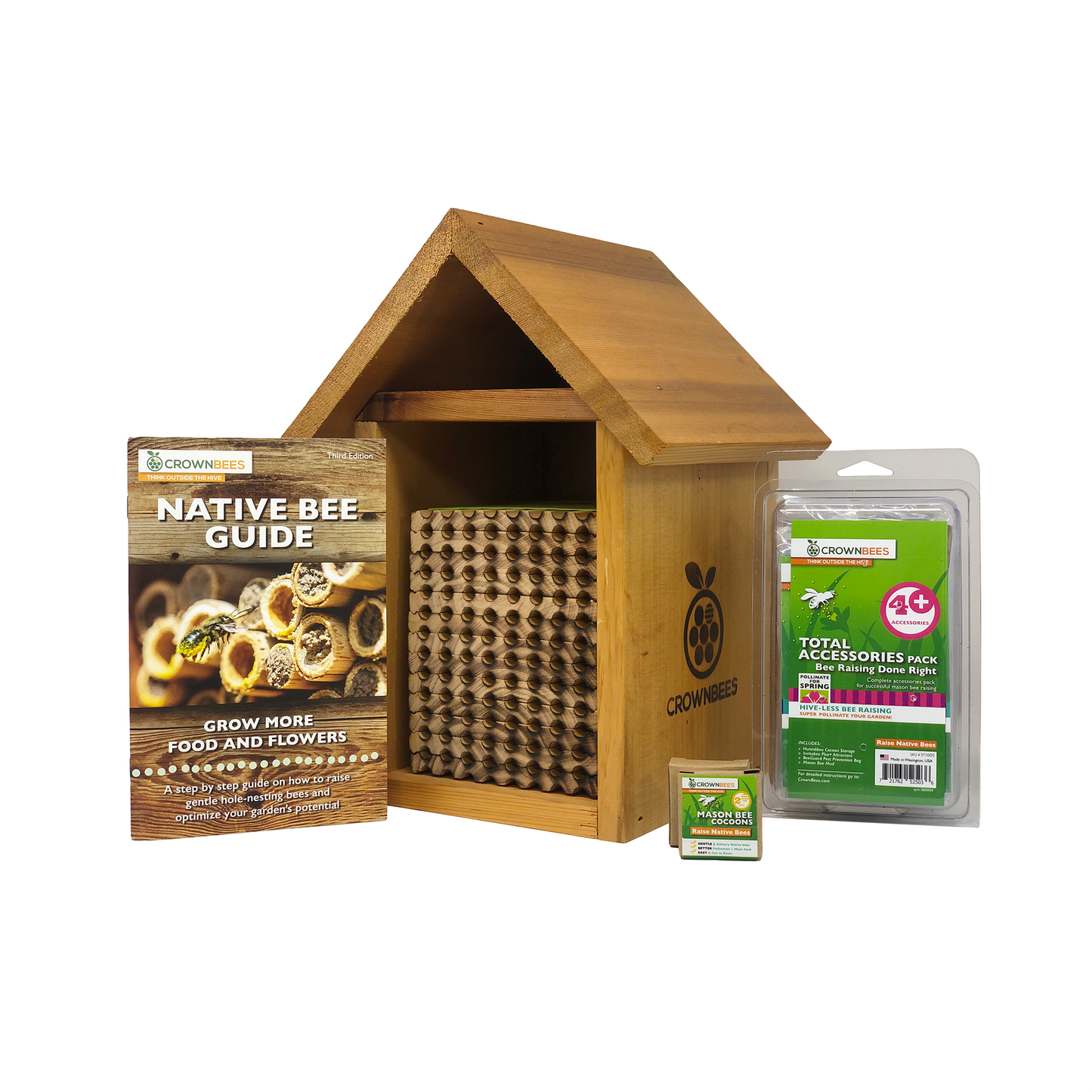Every animal employs a strategy (or multiple strategies) to efficiently forage for food. You are likely familiar with the strategy commonly used by birds, central place foraging.
Birds depart from their nests, a central place, to collect food and return to their nests to feed their offspring following each foraging trip. Similarly, most solitary bees collect floral resources (pollen, nectar, and sometimes floral oils) from flowers before they return to their nest to provision brood cells.
However, unlike birds, solitary bees are not progressive-provisioning, meaning they do not continuously provide food to their offspring as they mature. Instead, solitary bees create a floral resource mass, called a pollen provision, which they seal inside each brood cell as a food source for their larval offspring. This approach, called mass-provisioning, necessitates that the female bees provide sufficient floral resources for their developing larva, and ensures that the brood cells are free of pathogens and parasites before sealing each cell. In this module, we will focus on the first of the two requirements for successful mass-provisioning: providing sufficient floral resources. Students will be able to describe the structure of solitary bee foraging trips, what factors impact foraging success, and the importance of successful foraging for the fitness of the next generation after completing this module.
Foraging Trip Structure
For central place foraging bees, foraging trips begin and end at the nest. In order to find their way back to their nest, they fly an orientation flight on their first trip of the day (Figure 1). Orientation flights, an arced, zig-zagging flight pattern from the nest's entrance, allow the bee to memorize the nest entrance location and to find their nest among cluttered terrain and neighboring nests as they return from subsequent foraging trips.
Remembering the location of their nest is no small task, the duration of foraging trips can be anywhere from two minutes to two hours, during which bees can fly up to 6km, although most flights are less than 500m. Some small species (<3mm in length) forage at distances of less than 10m.

Figure 1. Orientation flight pattern used by solitary bees to memorize the location of their nest (redrawn from Tinbergen 1932; Danforth, Minckley, and Neff 2019)
Foraging distances have profound effects on a bee's reproductive success and the efficacy of managed pollinators in agriculture. Habitat fragmentation can extend foraging distances (see Drivers of bee decline and what you can do), reducing the accessibility of floral resources. In agriculture, knowing how far bees will travel to forage, and therefore pollinate, helps farmers decide the best way to distribute nesting boxes throughout the farm to ensure the bees pollinate the maximum number of flowers.
During active foraging, trips are frequent, occurring in bouts of several trips back-to-back with only a short time spent in the nest to deposit pollen and nectar between trips. The number of trips is species-dependent with species that are able to carry more pollen at a time making fewer trips. The number of trips is also dependent on the sex of the offspring they are provisioning. Smaller males require less pollen than females. Blue orchard bees make upwards of 75 trips to provision a single brood cell. After completing a pollen provision, bees spend longer in the nest during which they oviposit and seal the brood cell before departing for the next bout of foraging trips.
Abiotic Factors Impacting Foraging Behavior
Foraging behavior and efficiency depend on biological factors, such as forager age, and abiotic factors, including light intensity, floral resource availability, temperature, and precipitation. Most bees forage between 9:00 am and 4:00 pm, with a peak in activity at the warmest time of the day. Although not all bees follow this pattern, foraging activity depends on the light intensity, with the majority of bees being diurnal and most active in bright sunlight (Figure 2). Still, others are matinal (primarily active during the morning), vespertine (primarily active during the evening), crepuscular (active at dawn and dusk), and even nocturnal. Foraging activity is also dependent on the availability of floral resources, which can vary during the day as flowers open and close.

Figure 2. Osmia foraging at spring cherry blossoms, on a sunny spring day. Notice the yellow pollen-packed scopa on the underside of the bee’s abdomen (Image: © Edward Deng, iNaturalist)
Temperature is one of the most significant factors impacting bee foraging behavior. Cool weather can reduce the temp- erature of thoracic flight muscles below the threshold required for flight. Many bees are heterothermic—or facultative endotherms— meaning they are able to increase their body temperature above the threshold for flight through:
1. Basking,
2. Constructing nests that are warmed by the morning sun, or
3. Shivering thermogenesis, the rapid repeated constriction of flight muscles to generate heat.
By utilizing one or more of these techniques, early spring flyers, such as the Blue Orchard Bee, fly at temperatures down to 54°F. Body size and surface area to volume ratio also impact foraging behaviors, with high temperatures reducing foraging activity in large bees that cannot dissipate heat as easily and cold temperatures reducing foraging in small bees.
Local weather conditions, including precipitation and wind, may also reduce foraging. Honey bees are susceptible to the low temperatures, windy conditions, and precipitation that often coincide with spring fruit tree bloom making them ineffective pollinators, contributing to low crop yields. The Blue Orchard Bee and other mason bees are more resistant to poor weather, including low temperatures, wind, and even light rain. The use of mason bees as orchard pollinators mitigates the risk that poor weather conditions during bloom would reduce pollination and thereby reduce crop yield (See Mason Bees as Pollinators).
Foraging and Fitness
Foraging behavior impacts fitness and offspring production. Females must collect enough floral resources to feed the larva during development. If an insufficient quantity of floral resources is collected, larvae will not reach the ideal body size, increasing winter mortality, and reducing reproductive success in those that survive to the next spring.

Figure 3. An egg and pollen provision in an Osmia nest reed (Image: © entomart)
Foraging females may lay more male eggs when floral resources are scarce, since male offspring require smaller provisions than females (Figure 3, See Nesting and Mating Behavior and Sex Determination and Allocation). Creating a considerable male bias in sex ratio reduces the number of actively pollinating females in the next generation and potentially reduces the population size. More males alone cannot facilitate population growth.
Increased foraging distance and in turn foraging times may also increases parasite risk, reducing offspring production.
Common Misconceptions
Unlike honey bees, solitary bees do not live in social hives with dedicated worker bees responsible for foraging and nest construction. Instead, each female bee must independently forage for all of the floral resources they will incorporate into their nests. Another notable deviation between honey bees and solitary bees is how they transport pollen. Honey bees and bumble bees store a mixture of pollen and nectar stuck to their rear legs in a pollen basket (See Mason Bees as Pollinators). However, other species use pollen-collecting hairs called scopa, which are often found on their hind legs or the underside of their abdomen to carry pollen (see Bee Anatomy).
Glossary
Mass-provisioning - A provisioning behavior in which the full food supply for developing offspring is supplied at one time, allowing the offspring to eat and develop without any additional parental input
Progressive-provisioning - A provisioning behavior in which parents continuously feed their offspring during development
Orientation flight - A widening zig-zag flight pattern which is used by female bees to memorize their nest's location
Heterothermy – A form of body temperature regulation where an animal can self-regulate their body temperature or allow it to fluctuate along with ambient temperature
Mason Bee Foraging and Weather — Data Analysis
McKinney and Park’s 2012 publication used video cameras mounted in specially constructed bee hotels to study Osmia foraging behavior. Here, we will analyze figures adapted from this study to study how weather impacts bee behavior.

Figure 1. Osmia activity on a day without rain. Hour 0 corresponds with midnight (12:00 am)

Figure 2. Osmia activity on a day with rain
Background
The mason bee species Osmia cornifrons is a spring flying orchard pollinator commonly used in Japan, that was introduced to the United States for fruit tree pollination (we discuss the implications of this introduction in the module Drivers of Bee Decline and What you can do). It is a relative of the native Blue Orchard Bee (Osmia lignaria). Much like the Blue Orchard Bee, O. cornifrons is an effective pollinator of spring-flowering fruit trees in the family Rosaceae, such as apple and pear. Honey bees are less resilient in inclement weather, which can make them ineffective spring pollinators.

Figure 3. Osmia activity over the course of a day and the ambient temperature.
McKinney and Park used several cameras to document O. cornifrons foraging activity (pollen and nesting material collection) for ten bees over six days in May in West Virginia. They compared their observations of bee activity to hourly temperature and precipitation data from a local weather station. They presented these data in the figures above.
Interpreting the Figures
Figure 1 and Figure 2 shows the level of O. cornifrons activity during two days, one without precipitation (Figure 1) and the other with precipitation (Figure 2). Figure 3 shows Osmia activity over the course of a day and its relationship with ambient temperature.
Discussion Questions
1. How do temperature and precipitation affect bee foraging activity?
2. Other than temperature, what else might be responsible for the decline in activity at the end of the day?
3. What is a possible explanation for the decline in foraging activity at noon in Figure 3?
4. How might changes in local weather patterns due to climate change affect bee foraging activity? Would these figures look different if the researchers were observing honey bees? What differences would you expect to see?
5. Would these figures look different if the researchers were observing honeybees? What differences would you expect to see?
6. How might farmers use information about when bees are most active to inform their pesticide use strategies?
7. Other than precipitation, what might prevent bees from flying on rainy days? (Hint: In this study, the highest temperature observed on rainy days was only 14.4°C)
8. What do the authors mean by “activities initiated per hour”?
9. Why did the researchers choose to use line graphs with two Y axes?
BACKGROUND
Foraging Behavior Module PDF
FIGURES
ACTIVITIES
Foraging Behavior Activity PDF
Foraging Behavior Activity Answers PDF
RESOURCES
Bosch, J., & Kemp, W. P. (2002). How to manage the blue orchard bee. Sustainable Agricultural Network. Danforth, B. N., Minckley, R. L., & Neff, J. L. (2019). The Solitary Bees. Princeton, NJ: Princeton University Press.
McKinney, M. I., & Park, Y. L. (2012). Nesting activity and behavior of Osmia cornifrons (Hymenoptera: Megachilidae) elucidated using videography. Psyche (London), 2012. https://doi.org/10.1155/2012/814097
Vicens, N., & Bosch, J. (2000). Weather-dependent pollinator activity in an apple orchard, with special reference to Osmia cornuta and Apis mellifera (Hymenoptera: Megachilidae and Apidae). Environmental Entomology, 29(3), 413–420. https://doi.org/10.1603/0046-225X-29.3.413










